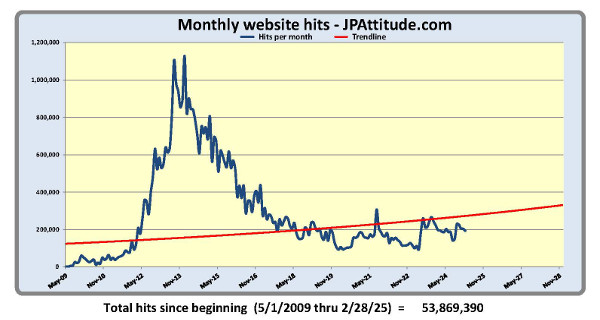Global warming thought experiment
February 22, 2010
As the theory of anthropogenic global warming (AGW) disintegrates under a barrage of scientific fraud, bureaucratic stupidity, political ham-handedness, and greed, it might be the perfect time to step back and try for fresh perspective with a thought experiment.
Pretend that your name is Isaac Galileo “Buster” Einstein and you are the most famous scientist in the world, winner of Nobel Prizes for Physics, Chemistry, and Medicine, as well as the Peace Prize simply because they ran out of other Nobel medals to give you. That’s how smart you are.
As you are gardening behind your home on the campus of MIT one day, growing four-foot-tall cabbages for starving Somalis, the president of the university stops by and says, “Hey Buster, the world needs your help.”
“Again?” you respond.
“Don’t get a big head, Buster,” says the president, looking at your garden.
“So what does the world need this time?”
“Well, here’s the deal: turns out the scientists in charge of climate studies are all nincompoops. Economists spouting off about physics, astronomers pretending to be statisticians, and every Tom, Dick, and Harry getting doctorates in “Climatology” and then pretending they know how to forecast the future with computer code. The United Nation’s climate change chief got his degree in social work, for God’s sake! The whole field is a mess.”
“I know.”
“You know?”
“I’m the smartest man in the world, remember? And I saw a story about it on Fox News last night.”
“Oh. Anyway, we want you to settle the issue of Earth’s temperature. Then tell us whether global warming is a problem. Capiche?”
“Okay, how long do I have?”
“Take as much time as you need. Call me this afternoon with the answers.”
So where do you begin? A stupid man with little grasp of basic science—somebody like Al Gore, say—might rush out to the driveway, hang a thermometer from a tree, and shout, “Voila!” But you’re too smart for that. You know that the temperature in your driveway doesn’t necessarily represent the whole planet.
While that should be glaringly obvious to anybody with common sense, the concept is surprisingly foreign to the field of climatology as practiced by the in-crowd—that exclusive clique of “scientists” who write reports for the U.N.’s Intergovernmental Panel on Climate Change (IPCC). The in-crowd—people like James Hansen and Michael Mann in the United States, the disgraced and suicidal Phil Jones in England, and others of that ilk—rush around placing thermometers randomly here and there, moving them without conscience, ignoring them or “adjusting” them when they give politically incorrect readings, and generally acting like a ten-year-old with a new magic trick. “Pick a card, Daddy, any card! No, not that one!”
While the U.N.’s Copenhagen Climate Conference was underway in December, the Russians complained about the in-crowd ignoring more and more of the temperature readings from Russia. Big surprise, turns out they’re ignoring the ones in Siberia, where it’s cold. Same thing in China—they’re ignoring temperature readings from cold places. Worldwide, they reduced the number of weather stations they use from 7,000 to 3,000 between 1975 and 2000.
Suspicious, eh? It’s almost like the grant money these guys get is dependent upon there being a Global Warming problem.
Big and disparate as the world is, you’d think the more temperature readings the better. If fewer is better, why not use one thermometer, put it in Al Gore’s driveway, and tell him to read it once a day at noon—make him earn his ridiculous Peace Prize?
You think about that for a second and dismiss the idea; partly because it’s stupid, partly because you lack faith in Gore’s ability to read a thermometer.
You also conclude that starting with a database of temperature readings with hundreds of readings from Siberia and then gradually removing those readings from the database over the course of thirty years will probably manufacture a database which shows warming, whether in fact the planet is warming or not.
In other words, current temperature databases are worthless. No wonder the world needs your help.
Beginning to grasp the extent of the mess in climatology, you walk into your living room, put your feet on the coffee table, fire up your best pipe, and ponder the concept of temperature. Eventually you arrive at three important questions:
If Martian temperatures are irrelevant to polar bears, so are temperatures in the Sahara and temperatures down in the molten core of the planet. The bears seldom have thermal contact with hot deserts or molten lava, and, if they do, they have larger issues than climate change.
Averaging temperatures in a vain effort to create a “temperature of the planet” doesn’t solve the irrelevancy of temperatures in far apart places. And when it comes to averaging them, well, life forms do not live in an average planetary temperature, no matter how you calculate it. If the temperature around your body is sixty degrees, for example, then that is the temperature with which the laws of thermodynamics demand equilibrium whether you are a polar bear or a redwood tree, and no matter how hot it is in Libya.
So the very concept of temperature requires that you first answer the question: “Temperature relative to what?” Because Temperature of Planet Earth is an inane and useless concept unless somebody or something is in thermal contact with the whole planet at once.
Even Al Gore’s fat ass doesn’t manage that.
Nevertheless, for the sake of covering all bases, you turn your Nobel-winning mind to the question of whether the temperature of the planet is measureable. And since the in-crowd seems to like actual physical thermometers, the first puzzle is where to put the thermometers.
(Hey, speaking of Al Gore’s fat ass...)
Imagine standing in your driveway with a wheelbarrow full of Kmart Blue Light Special thermometers, trying to decide where to put them. Where would you start?
If you put one in your driveway, how high (or how deep) do you place it? Since temperature changes with altitude, decreasing 3.5 degrees per 1,000 feet of elevation, and increases even faster when you go down into the ground, rising about ten times that fast with every 1,000 feet you burrow, the height (or depth) is rather crucial.
Oh, by the way, most of the planet is covered by water, and there’s temperature change with depth in the water, too. Deep ocean water is much colder than surface water.
And do you place your driveway thermometer in the sun or the shade? If the thermometer is in the shade, it won’t really represent temperatures in the sun, and if it’s in the sun it won’t represent temperatures in the shade. Likewise, if it’s close to the house, which radiates heat, it won’t represent temperatures away from the house.
And how about exposure to the elements? A thermometer that gets wet will be cooled by evaporation and give completely different readings than a thermometer that stays dry, even in a situation where ambient temperature is the same. Ditto with regard to wind exposure. You can’t avoid this issue by sheltering the thermometer from the elements because you’re attempting to measure the temperature of the whole planet, much of which sits out in the wind and gets wet.
The difficulty of picking one temperature to represent everything is why television weathermen give you at least two—the ambient and the wind chill—while trying to describe what it’s like outside.
In a laboratory setting which isolated the driveway from the rest of the world, temperatures would reach thermal equilibrium eventually and you could anticipate that equilibrium by sampling enough of the various driveway temperatures to be able to make a statistical prediction of that eventual equilibrium (although you still need a nearly infinite number of predictions to represent all the possible heights and depths), but in the real world things are changing constantly and the driveway never achieves equilibrium.
Sheesh, what a mess, eh? It’s a conundrum. Upon reflection, you see that a wheelbarrow full of Blue Light Special thermometers is insufficient to measure the temperature of even the tiny portion of the planet covered by your driveway, and the idea that you can measure the temperature of the whole planet with thermometers is absurd.
Never mind that thermometer readings are the basis for Global Warming theory—they came to you, Buster Einstein, because you can think outside the box and are willing to say it out loud when the emperor has no clothes. Clearly, when it comes to measuring temperature, the “emperors” of Global Warming have no clothes.
In defense of the IPCC crowd, they never actually claim to have a Temperature of Planet Earth. What they do is take their collection of temperature readings from their randomly placed—and frequently stupidly placed—thermometers and apply statistical analysis to them in an effort to coax identifiable trends from them.
This is a junior-high-school-level mathematical mistake. Not all collections of data accede to statistical analysis and there are two very good reasons why the IPCC-crowd’s temperature data does not.
Number one, you cannot use statistics to analyze numbers of unrelated items. A series of temperature readings from 20,000 feet up the north slope of Mount Everest is unrelated to a series of temperature readings from 200 feet below sea level in Death Valley. They are unrelated longitude-wise, altitude-wise, climate-wise, and a bunch of other -wises. You cannot average the two temperature series and create a mathematically meaningful outcome any more than you can average the number of refrigerators and the number of doors in your home and get something mathematically meaningful.
If somebody came to you and said, “I have counted the number of refrigerators and doors and dead flies and grains of salt in your house and the average number of things in your house is five thousand three hundred and twelve,” and then tried to convince you this was the best estimate for the number of beds in your home, you’d assume he was crazy. But that’s exactly what the IPCC promoters of AGW have been doing for three decades.
The second reason why IPCC temperature data does not accede to statistical analysis is because sometimes the data available does not expose the fundamental situation. Nassim Taleb calls these Black Swan situations, and invents an example of turkeys using statistical analysis to extrapolate 1000 straight days of plentiful food and uninterrupted growth into the future. They decide, of course, based upon their data, that plentiful food and uninterrupted growth will continue indefinitely, blissfully unaware that day 1001 is Thanksgiving. The data available to the turkeys did not expose the true nature of their lives.
In the same fashion, the data which the IPCC-crowd uses to prognosticate miniscule changes in global temperature disregards the true nature of our climate, which we happen to know is mostly a history of precipitous declines into lengthy ice ages, with only occasional forays into the warmer temperature ranges of the last 10,000 years. Sooner or later, our Thanksgiving will come. We’ll be freezing our butts off and praying for global warming when that happens.
At least we’re better off than the turkeys, because this knowledge is available to us, although the IPCC seems hell-bent on ignoring it.
Sighing, you look sadly at your empty pipe, and force your thoughts back to the topic of measuring Earth’s temperature. With thermometers discredited, is there another way?
It just so happens there is.
Using satellites, we can measure the albedo of the planet, calculate the incoming solar radiation, subtract the outgoing long-wave radiation, and arrive at a “temperature” of Planet Earth, relative to somebody in near-Earth orbit, which is somewhere in the vicinity of twenty degrees below the freezing point of water.
Although it works, and finally gives us a bona fide temperature reading for the planet as a whole, this calculation is notable for three reasons: one, it is far less accurate than the fractional temperature changes which the IPCC-crowd pretends to measure in support of AGW theory; two, it is dependent upon an estimation of the planet’s albedo (the reflective properties of the overall whiteness of its clouds and snow cover) which tends to change minute to minute and season to season and is therefore wildly inconsistent; and three, it is a marvelously useless number for almost every purpose for which we require temperature to be measured—unless Polar Bears and whippets suddenly start living in outer space.
20 degrees below the freezing point of water? Does anybody really feel that this temperature applies to them? Maybe polar bears and penguins could identify, but the rest of the planet would probably question this temperature calculation. The tube worms that live at subterranean hydrothermal vents, where the temperature is hundreds of degrees higher, certainly wouldn’t find it relevant to their existence. Neither would crocodiles, which probably have trouble hunting when the water is frozen solid.
In short, the measurement of the temperature of the whole planet for climate purposes is an impossible, irrelevant, and silly exercise in hubris by so-called scientists whose main goal is apparently something other than the advancement of science.
And if the measurement of the planet’s temperature is a no-go, the logical follow-up conclusion is that Anthropogenic Global Warming is either a nonexistent invention (at worst), or an unknowable conjecture until its magnitude exceeds the magnitude of the error inherent in the calculation of the planet’s temperature by satellites.
You’ve reached these conclusions without leaving your living room and without spending one dime of grant money from the government. Picking up the phone, you call the president of MIT.
“Damn, I hope this doesn’t mean another trip to Oslo,” you think to yourself.
From Reno, Nevada, USA
Pretend that your name is Isaac Galileo “Buster” Einstein and you are the most famous scientist in the world, winner of Nobel Prizes for Physics, Chemistry, and Medicine, as well as the Peace Prize simply because they ran out of other Nobel medals to give you. That’s how smart you are.
As you are gardening behind your home on the campus of MIT one day, growing four-foot-tall cabbages for starving Somalis, the president of the university stops by and says, “Hey Buster, the world needs your help.”
“Again?” you respond.
“Don’t get a big head, Buster,” says the president, looking at your garden.
“So what does the world need this time?”
“Well, here’s the deal: turns out the scientists in charge of climate studies are all nincompoops. Economists spouting off about physics, astronomers pretending to be statisticians, and every Tom, Dick, and Harry getting doctorates in “Climatology” and then pretending they know how to forecast the future with computer code. The United Nation’s climate change chief got his degree in social work, for God’s sake! The whole field is a mess.”
“I know.”
“You know?”
“I’m the smartest man in the world, remember? And I saw a story about it on Fox News last night.”
“Oh. Anyway, we want you to settle the issue of Earth’s temperature. Then tell us whether global warming is a problem. Capiche?”
“Okay, how long do I have?”
“Take as much time as you need. Call me this afternoon with the answers.”
So where do you begin? A stupid man with little grasp of basic science—somebody like Al Gore, say—might rush out to the driveway, hang a thermometer from a tree, and shout, “Voila!” But you’re too smart for that. You know that the temperature in your driveway doesn’t necessarily represent the whole planet.
While that should be glaringly obvious to anybody with common sense, the concept is surprisingly foreign to the field of climatology as practiced by the in-crowd—that exclusive clique of “scientists” who write reports for the U.N.’s Intergovernmental Panel on Climate Change (IPCC). The in-crowd—people like James Hansen and Michael Mann in the United States, the disgraced and suicidal Phil Jones in England, and others of that ilk—rush around placing thermometers randomly here and there, moving them without conscience, ignoring them or “adjusting” them when they give politically incorrect readings, and generally acting like a ten-year-old with a new magic trick. “Pick a card, Daddy, any card! No, not that one!”
While the U.N.’s Copenhagen Climate Conference was underway in December, the Russians complained about the in-crowd ignoring more and more of the temperature readings from Russia. Big surprise, turns out they’re ignoring the ones in Siberia, where it’s cold. Same thing in China—they’re ignoring temperature readings from cold places. Worldwide, they reduced the number of weather stations they use from 7,000 to 3,000 between 1975 and 2000.
Suspicious, eh? It’s almost like the grant money these guys get is dependent upon there being a Global Warming problem.
Big and disparate as the world is, you’d think the more temperature readings the better. If fewer is better, why not use one thermometer, put it in Al Gore’s driveway, and tell him to read it once a day at noon—make him earn his ridiculous Peace Prize?
You think about that for a second and dismiss the idea; partly because it’s stupid, partly because you lack faith in Gore’s ability to read a thermometer.
You also conclude that starting with a database of temperature readings with hundreds of readings from Siberia and then gradually removing those readings from the database over the course of thirty years will probably manufacture a database which shows warming, whether in fact the planet is warming or not.
In other words, current temperature databases are worthless. No wonder the world needs your help.
Beginning to grasp the extent of the mess in climatology, you walk into your living room, put your feet on the coffee table, fire up your best pipe, and ponder the concept of temperature. Eventually you arrive at three important questions:
1. What is temperature?By definition, temperature is the measure of how hot or cold something is (duh), which in turn results from the motion of particles at the atomic level. Intrinsic to any definition of temperature, however, is the assumption of thermal contact. If you never have thermal contact with something, its temperature is irrelevant. Polar bears might be comfortable, temperature-wise, on Mars (whereas whippets would be miserable), but who cares? The likelihood of polar bears (or whippets) traveling to Mars is small.
2. Can the temperature of Planet Earth be measured?
3. What meaning would such a measurement have for climate?
If Martian temperatures are irrelevant to polar bears, so are temperatures in the Sahara and temperatures down in the molten core of the planet. The bears seldom have thermal contact with hot deserts or molten lava, and, if they do, they have larger issues than climate change.
Averaging temperatures in a vain effort to create a “temperature of the planet” doesn’t solve the irrelevancy of temperatures in far apart places. And when it comes to averaging them, well, life forms do not live in an average planetary temperature, no matter how you calculate it. If the temperature around your body is sixty degrees, for example, then that is the temperature with which the laws of thermodynamics demand equilibrium whether you are a polar bear or a redwood tree, and no matter how hot it is in Libya.
So the very concept of temperature requires that you first answer the question: “Temperature relative to what?” Because Temperature of Planet Earth is an inane and useless concept unless somebody or something is in thermal contact with the whole planet at once.
Even Al Gore’s fat ass doesn’t manage that.
Nevertheless, for the sake of covering all bases, you turn your Nobel-winning mind to the question of whether the temperature of the planet is measureable. And since the in-crowd seems to like actual physical thermometers, the first puzzle is where to put the thermometers.
(Hey, speaking of Al Gore’s fat ass...)
Imagine standing in your driveway with a wheelbarrow full of Kmart Blue Light Special thermometers, trying to decide where to put them. Where would you start?
If you put one in your driveway, how high (or how deep) do you place it? Since temperature changes with altitude, decreasing 3.5 degrees per 1,000 feet of elevation, and increases even faster when you go down into the ground, rising about ten times that fast with every 1,000 feet you burrow, the height (or depth) is rather crucial.
Oh, by the way, most of the planet is covered by water, and there’s temperature change with depth in the water, too. Deep ocean water is much colder than surface water.
And do you place your driveway thermometer in the sun or the shade? If the thermometer is in the shade, it won’t really represent temperatures in the sun, and if it’s in the sun it won’t represent temperatures in the shade. Likewise, if it’s close to the house, which radiates heat, it won’t represent temperatures away from the house.
And how about exposure to the elements? A thermometer that gets wet will be cooled by evaporation and give completely different readings than a thermometer that stays dry, even in a situation where ambient temperature is the same. Ditto with regard to wind exposure. You can’t avoid this issue by sheltering the thermometer from the elements because you’re attempting to measure the temperature of the whole planet, much of which sits out in the wind and gets wet.
The difficulty of picking one temperature to represent everything is why television weathermen give you at least two—the ambient and the wind chill—while trying to describe what it’s like outside.
In a laboratory setting which isolated the driveway from the rest of the world, temperatures would reach thermal equilibrium eventually and you could anticipate that equilibrium by sampling enough of the various driveway temperatures to be able to make a statistical prediction of that eventual equilibrium (although you still need a nearly infinite number of predictions to represent all the possible heights and depths), but in the real world things are changing constantly and the driveway never achieves equilibrium.
Sheesh, what a mess, eh? It’s a conundrum. Upon reflection, you see that a wheelbarrow full of Blue Light Special thermometers is insufficient to measure the temperature of even the tiny portion of the planet covered by your driveway, and the idea that you can measure the temperature of the whole planet with thermometers is absurd.
Never mind that thermometer readings are the basis for Global Warming theory—they came to you, Buster Einstein, because you can think outside the box and are willing to say it out loud when the emperor has no clothes. Clearly, when it comes to measuring temperature, the “emperors” of Global Warming have no clothes.
In defense of the IPCC crowd, they never actually claim to have a Temperature of Planet Earth. What they do is take their collection of temperature readings from their randomly placed—and frequently stupidly placed—thermometers and apply statistical analysis to them in an effort to coax identifiable trends from them.
This is a junior-high-school-level mathematical mistake. Not all collections of data accede to statistical analysis and there are two very good reasons why the IPCC-crowd’s temperature data does not.
Number one, you cannot use statistics to analyze numbers of unrelated items. A series of temperature readings from 20,000 feet up the north slope of Mount Everest is unrelated to a series of temperature readings from 200 feet below sea level in Death Valley. They are unrelated longitude-wise, altitude-wise, climate-wise, and a bunch of other -wises. You cannot average the two temperature series and create a mathematically meaningful outcome any more than you can average the number of refrigerators and the number of doors in your home and get something mathematically meaningful.
If somebody came to you and said, “I have counted the number of refrigerators and doors and dead flies and grains of salt in your house and the average number of things in your house is five thousand three hundred and twelve,” and then tried to convince you this was the best estimate for the number of beds in your home, you’d assume he was crazy. But that’s exactly what the IPCC promoters of AGW have been doing for three decades.
The second reason why IPCC temperature data does not accede to statistical analysis is because sometimes the data available does not expose the fundamental situation. Nassim Taleb calls these Black Swan situations, and invents an example of turkeys using statistical analysis to extrapolate 1000 straight days of plentiful food and uninterrupted growth into the future. They decide, of course, based upon their data, that plentiful food and uninterrupted growth will continue indefinitely, blissfully unaware that day 1001 is Thanksgiving. The data available to the turkeys did not expose the true nature of their lives.
In the same fashion, the data which the IPCC-crowd uses to prognosticate miniscule changes in global temperature disregards the true nature of our climate, which we happen to know is mostly a history of precipitous declines into lengthy ice ages, with only occasional forays into the warmer temperature ranges of the last 10,000 years. Sooner or later, our Thanksgiving will come. We’ll be freezing our butts off and praying for global warming when that happens.
At least we’re better off than the turkeys, because this knowledge is available to us, although the IPCC seems hell-bent on ignoring it.
Sighing, you look sadly at your empty pipe, and force your thoughts back to the topic of measuring Earth’s temperature. With thermometers discredited, is there another way?
It just so happens there is.
Using satellites, we can measure the albedo of the planet, calculate the incoming solar radiation, subtract the outgoing long-wave radiation, and arrive at a “temperature” of Planet Earth, relative to somebody in near-Earth orbit, which is somewhere in the vicinity of twenty degrees below the freezing point of water.
Although it works, and finally gives us a bona fide temperature reading for the planet as a whole, this calculation is notable for three reasons: one, it is far less accurate than the fractional temperature changes which the IPCC-crowd pretends to measure in support of AGW theory; two, it is dependent upon an estimation of the planet’s albedo (the reflective properties of the overall whiteness of its clouds and snow cover) which tends to change minute to minute and season to season and is therefore wildly inconsistent; and three, it is a marvelously useless number for almost every purpose for which we require temperature to be measured—unless Polar Bears and whippets suddenly start living in outer space.
20 degrees below the freezing point of water? Does anybody really feel that this temperature applies to them? Maybe polar bears and penguins could identify, but the rest of the planet would probably question this temperature calculation. The tube worms that live at subterranean hydrothermal vents, where the temperature is hundreds of degrees higher, certainly wouldn’t find it relevant to their existence. Neither would crocodiles, which probably have trouble hunting when the water is frozen solid.
In short, the measurement of the temperature of the whole planet for climate purposes is an impossible, irrelevant, and silly exercise in hubris by so-called scientists whose main goal is apparently something other than the advancement of science.
And if the measurement of the planet’s temperature is a no-go, the logical follow-up conclusion is that Anthropogenic Global Warming is either a nonexistent invention (at worst), or an unknowable conjecture until its magnitude exceeds the magnitude of the error inherent in the calculation of the planet’s temperature by satellites.
You’ve reached these conclusions without leaving your living room and without spending one dime of grant money from the government. Picking up the phone, you call the president of MIT.
“Damn, I hope this doesn’t mean another trip to Oslo,” you think to yourself.
From Reno, Nevada, USA
February 22, 2010 - Actually, the debate about Global Warming isn't that it exist or not but what is causing it. Democrats for a long time have believed that Global Warming is real and only recently the Republicans have come to realize that Global Warming is real. People in other countries believe it is real, while fewer Americans believe it is real. The Democrats think people are causing it so we have to do something about it. The Republicans think it is happening and people are not causing it and God forbid that we blame it on power plants, coal, chemical plants or any other business. Also, Scientist measure the amount of UV light that hits Earth and don't just rely on thermometers. The UV light and the amount trapped in the atmosphere has been increasing. You can also find a lot of pictures of ice breaking off Antarctica. [Link1 Link2] Why other countries believe Global Warming is real. [Link1 Link2 Link3] The newest twist in this is, "Global Warming is real and if it causes some real problems, we will look pretty foolish or bad if we don't try to do something about it." So the biggest problem is what is the best solution for our money. - Rudy, Reno
February 22, 2010 - All I can say is...they need you on Fox News...sort of like an Andy Rooney style commentator...only younger, conservative and without the bushy eyebrows. And instead of 5 minutes, you'd require the full 60. But it would be worth it!! Love your stuff, Buster. - Boomer Pie, Florida
February 22, 2010 - Just want to say that I appreciate your humorous and logical approach to the absurdity that is "global warming". We all know (even the dweebs who are pushing this theory - even Al "fat ass" Gore - well maybe I go too far with that - after all a man who invented the internet - now really, what does he know about taking temperatures?) that those who tout this nonsense do it so they can travel, in style, with whole families in tow, to conferences in expensive scenic places. But I bet we aren't going to catch them holding a conference in Siberia, thermometers in hand. - Jane, Indiana
J.P. replies: Rudy, when I said that the theory of Anthropogenic Global Warming is disintegrating, I wasn't making that up. You've provided some links about ice melting and causing the sea levels to rise. That idea is straight from the 2007 IPCC report, which Al Gore then reused in his ridiculous documentary, An Inconvenient Truth, for which he won an Oscar and for which he and the IPCC shared a Nobel Peace Prize. [Gag.] Just yesterday, the scientists behind the paper on which the claims about sea level were based WITHDREW THEIR PAPER, admitting errors in their calculations. Do you realize how many claims from the 2007 IPCC report have subsequently been shown to be pure B.S.?
February 22, 2010 - All I can say is...they need you on Fox News...sort of like an Andy Rooney style commentator...only younger, conservative and without the bushy eyebrows. And instead of 5 minutes, you'd require the full 60. But it would be worth it!! Love your stuff, Buster. - Boomer Pie, Florida
February 22, 2010 - Just want to say that I appreciate your humorous and logical approach to the absurdity that is "global warming". We all know (even the dweebs who are pushing this theory - even Al "fat ass" Gore - well maybe I go too far with that - after all a man who invented the internet - now really, what does he know about taking temperatures?) that those who tout this nonsense do it so they can travel, in style, with whole families in tow, to conferences in expensive scenic places. But I bet we aren't going to catch them holding a conference in Siberia, thermometers in hand. - Jane, Indiana













